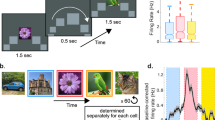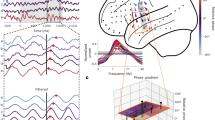Abstract
Learning from novel experiences is a major task of the central nervous system. In mammals, the medial temporal lobe is crucial for this rapid form of learning1. The modification of synapses and neuronal circuits through plasticity is thought to underlie memory formation2. The induction of synaptic plasticity is favoured by coordinated action-potential timing across populations of neurons3. Such coordinated activity of neural populations can give rise to oscillations of different frequencies, recorded in local field potentials. Brain oscillations in the theta frequency range (3–8 Hz) are often associated with the favourable induction of synaptic plasticity as well as behavioural memory4. Here we report the activity of single neurons recorded together with the local field potential in humans engaged in a learning task. We show that successful memory formation in humans is predicted by a tight coordination of spike timing with the local theta oscillation. More stereotyped spiking predicts better memory, as indicated by higher retrieval confidence reported by subjects. These findings provide a link between the known modulation of theta oscillations by many memory-modulating behaviours and circuit mechanisms of plasticity.
This is a preview of subscription content, access via your institution
Access options
Subscribe to this journal
Receive 51 print issues and online access
$199.00 per year
only $3.90 per issue
Buy this article
- Purchase on Springer Link
- Instant access to full article PDF
Prices may be subject to local taxes which are calculated during checkout




Similar content being viewed by others
References
Squire, L. R., Stark, C. E. & Clark, R. E. The medial temporal lobe. Annu. Rev. Neurosci. 27, 279–306 (2004)
Martin, S. J., Grimwood, P. D. & Morris, R. G. Synaptic plasticity and memory: an evaluation of the hypothesis. Annu. Rev. Neurosci. 23, 649–711 (2000)
Markram, H., Lubke, J., Frotscher, M. & Sakmann, B. Regulation of synaptic efficacy by coincidence of postsynaptic APs and EPSPs. Science 275, 213–215 (1997)
Buzsáki, G. Theta oscillations in the hippocampus. Neuron 33, 325–340 (2002)
Paller, K. A. & Wagner, A. D. Observing the transformation of experience into memory. Trends Cogn. Sci. 6, 93–102 (2002)
Buzsáki, G., Leung, L. W. & Vanderwolf, C. H. Cellular bases of hippocampal EEG in the behaving rat. Brain Res. 287, 139–171 (1983)
Jacobs, J., Kahana, M. J., Ekstrom, A. D. & Fried, I. Brain oscillations control timing of single-neuron activity in humans. J. Neurosci. 27, 3839–3844 (2007)
Paré, D. & Gaudreau, H. Projection cells and interneurons of the lateral and basolateral amygdala: distinct firing patterns and differential relation to theta and delta rhythms in conscious cats. J. Neurosci. 16, 3334–3350 (1996)
Pavlides, C., Greenstein, Y. J., Grudman, M. & Winson, J. Long-term potentiation in the dentate gyrus is induced preferentially on the positive phase of theta-rhythm. Brain Res. 439, 383–387 (1988)
Winson, J. Loss of hippocampal theta rhythm results in spatial memory deficit in the rat. Science 201, 160–163 (1978)
Hasselmo, M. E., Bodelon, C. & Wyble, B. P. A proposed function for hippocampal theta rhythm: separate phases of encoding and retrieval enhance reversal of prior learning. Neural Comput. 14, 793–817 (2002)
Lisman, J. E. & Idiart, M. A. Storage of 7 ± 2 short-term memories in oscillatory subcycles. Science 267, 1512–1515 (1995)
Berry, S. D. & Thompson, R. F. Prediction of learning rate from the hippocampal electroencephalogram. Science 200, 1298–1300 (1978)
Cantero, J. L. et al. Sleep-dependent theta oscillations in the human hippocampus and neocortex. J. Neurosci. 23, 10897–10903 (2003)
Kahana, M. J., Sekuler, R., Caplan, J. B., Kirschen, M. & Madsen, J. R. Human theta oscillations exhibit task dependence during virtual maze navigation. Nature 399, 781–784 (1999)
Huh, K. et al. Human hippocampal EEG: effects of behavioral activation. Neurology 40, 1177–1181 (1990)
Lee, H., Simpson, G. V., Logothetis, N. K. & Rainer, G. Phase locking of single neuron activity to theta oscillations during working memory in monkey extrastriate visual cortex. Neuron 45, 147–156 (2005)
Klimesch, W., Doppelmayr, M., Russegger, H. & Pachinger, T. Theta band power in the human scalp EEG and the encoding of new information. Neuroreport 7, 1235–1240 (1996)
Sederberg, P. B. et al. Hippocampal and neocortical gamma oscillations predict memory formation in humans. Cereb. Cortex 17, 1190–1196 (2007)
Fries, P., Reynolds, J. H., Rorie, A. E. & Desimone, R. Modulation of oscillatory neuronal synchronization by selective visual attention. Science 291, 1560–1563 (2001)
Rizzuto, D. S., Madsen, J. R., Bromfield, E. B., Schulze-Bonhage, A. & Kahana, M. J. Human neocortical oscillations exhibit theta phase differences between encoding and retrieval. Neuroimage 31, 1352–1358 (2006)
Seager, M. A., Johnson, L. D., Chabot, E. S., Asaka, Y. & Berry, S. D. Oscillatory brain states and learning: impact of hippocampal theta-contingent training. Proc. Natl Acad. Sci. USA 99, 1616–1620 (2002)
Siapas, A. G., Lubenov, E. V. & Wilson, M. A. Prefrontal phase locking to hippocampal theta oscillations. Neuron 46, 141–151 (2005)
Brown, R. A., Walling, S. G., Milway, J. S. & Harley, C. W. Locus ceruleus activation suppresses feedforward interneurons and reduces β-γ electroencephalogram frequencies while it enhances θ frequencies in rat dentate gyrus. J. Neurosci. 25, 1985–1991 (2005)
Orzeł-Gryglewska, J., Jurkowlaniec, E. & Trojniar, W. Microinjection of procaine and electrolytic lesion in the ventral tegmental area suppresses hippocampal theta rhythm in urethane-anesthetized rats. Brain Res. Bull. 68, 295–309 (2006)
Knight, R. Contribution of human hippocampal region to novelty detection. Nature 383, 256–259 (1996)
Rutishauser, U., Mamelak, A. N. & Schuman, E. M. Single-trial learning of novel stimuli by individual neurons of the human hippocampus-amygdala complex. Neuron 49, 805–813 (2006)
Viskontas, I. V., Knowlton, B. J., Steinmetz, P. N. & Fried, I. Differences in mnemonic processing by neurons in the human hippocampus and parahippocampal regions. J. Cogn. Neurosci. 18, 1654–1662 (2006)
Rutishauser, U., Schuman, E. M. & Mamelak, A. N. Activity of human hippocampal and amygdala neurons during retrieval of declarative memories. Proc. Natl Acad. Sci. USA 105, 329–334 (2008)
Adolphs, R., Denburg, N. L. & Tranel, D. The amygdala’s role in long-term declarative memory for gist and detail. Behav. Neurosci. 115, 983–992 (2001)
Nelson, M. J., Pouget, P., Nilsen, E. A., Patten, C. D. & Schall, J. D. Review of signal distortion through metal microelectrode recording circuits and filters. J. Neurosci. Methods 169, 141–157 (2008)
Duvernoy, H. M. The Human Hippocampus 3rd edn, 165–217 (Springer, 2005)
Brainard, D. H. The Psychophysics Toolbox. Spat. Vis. 10, 433–436 (1997)
Rutishauser, U., Schuman, E. M. & Mamelak, A. N. Online detection and sorting of extracellularly recorded action potentials in human medial temporal lobe recordings, in vivo. J. Neurosci. Methods 154, 204–224 (2006)
Milstein, J., Mormann, F., Fried, I. & Koch, C. Neuronal shot noise and Brownian 1/f2 behavior in the local field potential. PLoS ONE 4, e4338 (2009)
Mitra, P. P. & Bokil, H. Observed Brain Dynamics (Oxford Univ. Press, 2008)
Jarvis, M. R. & Mitra, P. P. Sampling properties of the spectrum and coherency of sequences of action potentials. Neural Comput. 13, 717–749 (2001)
Efron, B. & Tibshirani, R. J. An Introduction to the Bootstrap 202–236 (Chapman & Hall, 1993)
Tallon-Baudry, C., Bertrand, O., Delpuech, C. & Pernier, J. Stimulus specificity of phase-locked and non-phase-locked 40 Hz visual responses in human. J. Neurosci. 16, 4240–4249 (1996)
Acknowledgements
We thank all patients for their participation; the staff of the Huntington Memorial Hospital epilepsy unit; C. Heller, L. Philpot and W. Sutherling for their support; and F. Mormann, G. Laurent and R. Adolphs for discussion. Funding was provided by the Gordon and Betty Moore Foundation, the William T. Gimbel Discovery Fund and the Howard Hughes Medical Institute.
Author Contributions U.R. designed and performed experiments, wrote analysis methods, analysed data and wrote the paper; A.N.M. and I.B.R. performed surgery; A.N.M. designed experiments; E.M.S. designed experiments and wrote the paper. All authors discussed the results.
Author information
Authors and Affiliations
Corresponding author
Ethics declarations
Competing interests
The authors declare no competing financial interests.
Supplementary information
Supplementary Information
This file contains Supplementary Figures S1-S12 with legends, Supplementary Table 1, a Supplementary Discussion and Supplementary References. (PDF 1529 kb)
Rights and permissions
About this article
Cite this article
Rutishauser, U., Ross, I., Mamelak, A. et al. Human memory strength is predicted by theta-frequency phase-locking of single neurons. Nature 464, 903–907 (2010). https://doi.org/10.1038/nature08860
Received:
Accepted:
Published:
Issue Date:
DOI: https://doi.org/10.1038/nature08860
This article is cited by
-
Optogenetic frequency scrambling of hippocampal theta oscillations dissociates working memory retrieval from hippocampal spatiotemporal codes
Nature Communications (2023)
-
Acetylcholine modulates the temporal dynamics of human theta oscillations during memory
Nature Communications (2023)
-
A wearable platform for closed-loop stimulation and recording of single-neuron and local field potential activity in freely moving humans
Nature Neuroscience (2023)
-
Theta oscillations represent collective dynamics of multineuronal membrane potentials of murine hippocampal pyramidal cells
Communications Biology (2023)
-
Neural Correlates of Spatial Navigation in Primate Hippocampus
Neuroscience Bulletin (2023)
Comments
By submitting a comment you agree to abide by our Terms and Community Guidelines. If you find something abusive or that does not comply with our terms or guidelines please flag it as inappropriate.



